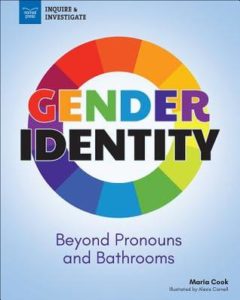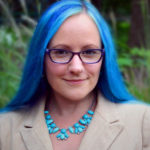“Transgender and Non-Binary People Have Always Been Here”
There’s been a lot of news in the last few years about transgender and non-binary people. Yet many folks don’t know for sure what the words “transgender” or “non-binary” mean.
Adding to the confusion are headlines and articles that declare that the fight for transgender and non-binary people’s rights are “the newest frontier in civil rights!” While this may be well-meaning, it is incorrect. The fight for transgender and non-binary rights is not new. Far from it! Transgender and non-binary people are not a fad, a trend, or a new phenomenon. They have always been here, from the beginning of human history. Which means that they have made incredible contributions to the world, in the form of protests, art, important writings, and more. What a cool—and important—fact for young people to learn!
In Gender Identity: Beyond Pronouns and Bathrooms, my goal was to create a resource that would allow young people to do three things: to learn what gender identity is (and thereby learn how to refer to people with differing gender identities), to unlearn the idea that the fight for trans and non-binary rights is a new thing, and to meet the incredible transgender, non-binary, intersex, and gender non-conforming people who have shaped American history.
As a young person, I loved learning about history. But some teaching methods are more effective than others. In my opinion, the best way to teach history is by introducing readers to the people who made history happen.
Every American should know about LGBTQ rights activists like Sylvia Rivera and Marsha P. Johnson, who marched for equality even when some in the LGBTQ tried to exclude them. Every American should also know about the incredible transgender people making history right now, like superstar actress Laverne Cox, the first openly transgender woman to win a Daytime Emmy Award and the first to appear on the cover of Time Magazine. And what about politician Christine Hallquist, the first openly transgender major party nominee for governor in the United States, who also happened to write the forward for this book? I believe that the stories of these incredible people will stick with readers long after they’ve set this book down.
I hope that cisgender readers (readers whose gender identity aligns with the gender they were assigned at birth) can learn how to relate and appreciate those whose gender identity differs from their own. I hope that transgender and non-binary readers can learn that they are not alone, nor have they ever been. And I hope educators who bring this book into their classrooms can use it to help them navigate this sensitive but incredibly important topic.
Below are two activities from the book which are intended to help readers explore the issue of gender identity in an easy-to-understand way.
Explore Cultural Expectations
Cultural expectations change over time, including expectations of men and women. For example, high-heeled shoes, which are now associated with women’s fashion, were originally created for men. In this activity, you’ll explore some cultural expectations and explore how they might have changed, from past to present.
- Find three items or behaviors that your culture associates with women. Do some research online or at the library or a museum to discover their origins. Can you find the first instance of the items or behaviors? Why do we associate them with women?
- Then do the same for three items or behaviors expected of men. Consider the following questions:
- How did the items or behaviors come to be?
- How have they changed, over time?
- Was there a defining moment in history that caused the expectations to change?
Write about your findings and include sources. Present what you have learned to other people and discuss your findings with one another.
Time to Move!
Now that you know about the beginnings of the LGBTQ rights movement, research the events that sparked one of America’s other civil rights movements in the 1960s, such as the African American civil rights movement or the women’s liberation movement.
- What’s similar between the beginnings of these two movements? What’s different?
- Civil rights movements are an important part of the history of the United States. Can you imagine what life would be like for women if the women’s rights movement had never occurred? What about the lives of African Americans—how would they be different if the country had never heard the speeches of Martin Luther King Jr. or seen the power of the March on Washington?
- Research the early beginnings of a few civil rights movements. Consider these questions:
- What did these movements have in common?
- What was different about them?
- Did every movement have certain leaders who stood out? What were they like?
- Are there movements just beginning today that have similarities to these movements?
- Draw a Venn Diagram to show what these early movements had in common and how they differed. What conclusions can you draw from your research?
More classroom resources can be found at https://nomadpress.net/wordpress/wp-content/uploads/2018/07/Gender-ID-Classroom-Guide.pdf.
Gender Identity: Beyond Pronouns and Bathrooms
Author: Maria Cook
Illustrator: Alexis Cornell
Published April 9th, 2019 by Nomad Press
About the Book: What does it mean to think of gender as being a range instead of simply male or female?
Gender Identity: Beyond Pronouns and Bathrooms invites readers to consider the cultural significance of gender identity in the United States and beyond. Middle and high schoolers learn about the history of LGBT rights, with a particular focus on transgender rights and the rights of gender-variant people, while engaging in research activities to help put what they have learned into context. These activities encourage teens to form their own, well-informed opinions about public figures, historical events, and current news regarding gender identity.
Busting the myth that the gender identity movement is a new phenomenon, this book teaches teens about some of the first openly transgender public figures in history, such as Lili Elbe, the first recorded person to ever medically transition in the 1930s, and Christine Jorgensen, who medically transitioned and rose to fame in the 1950s. The stories of activists and other important public figures are highlighted throughout the book and offer plenty of opportunity to connect with the history of the gender identity movement on a human level. From the Stonewall riots to the institution of the Transgender Day of Remembrance, teens will gain a rich understanding of how gender identity fits into culture, past and present.
About the Author: Maria Cook is an award-winning freelance writer who holds a BS in secondary English education and an MFA in writing, both from Butler University. Her nonfiction can be found in such publications as Marie Claire, Narratively, and Green Matters. Maria lives in Indianapolis, Indiana.
Thank you so much for this guest post about this topic that is such an important topic and this book is so needed for so many!



It isn’t a ‘new’ thing, I agree. Those who believe they know no one today who is in need of support or who would like to understand terms new to them, your book will be wonderful. From a grown student who is now a professor teaching in this area to a trans student who came out in her high school to a granddaughter’s first-grade classmate, it is part of my life, I’m sure it’s part of everyone’s, and it has been around a long time. Thanks for the post & for your book!